Inter-Comparison and Evaluation of Remote Sensing Precipitation Products over China from 2005 to 2013
Abstract
:1. Introduction
2. Satellite and Rain Gauge Precipitation Datasets
2.1. Satellite-Based Precipitation Products
2.2. Gauge Stations
3. Statistical Evaluation Methods
4. Results and Discussion
4.1. Evaluation on the Regional Scale
4.1.1. Nine-Year Daily Mean Precipitation
4.1.2. Seasonal Daily Mean Precipitation
4.1.3. Monthly Daily Mean Precipitation
4.2. Probability Distribution and Contingency Statistics
4.3. Typical Regional Analysis
5. Conclusions
- (1)
- According to the nine-year daily mean precipitation over China (Figure 2 and Figure 3), the characteristics of precipitation is clearly gradually increasing in the south and decreasing in the northern regions of the Qinling Mountain and Huaihe River. There is more than 10 mm/day in the south and less than 5 mm/day in the northwest. Among the five satellite products, GSMaP_RENALYSIS suggests the best performance with the highest of R (0.91) and the lowest RMSE (0.85 mm/day). CMORPH_RAW demonstrates the poorest capability with the lowest of R (0.73) and higher RMSE (2.79 mm/day). For the CC, RMSE and BIAS each annual daily mean precipitation from 2005 to 2013 (Table 3), GSMaP_RENALYSIS gives the highest CC (>0.8) and smallest RMSE (~1.2 mm/day) and the low BIAS (±0.1) in every year. GSMaP_RENALYSIS underestimates precipitation from 2005 to 2006 but it overestimates precipitation from 2007 to 2013. CMORPH_BLD, CMORPH_RAW and TRMM3BV42 exhibit underestimation precipitation but PERSIANN_CDR shows overestimation precipitation.
- (2)
- For the seasonal daily mean precipitation, the maximum precipitation is more than 15 mm/day in summer and about 5 mm/day in winter. Five satellite products show the best capability with the highest CC (~0.8) and the smallest RMSE (~1 mm/day) but relatively the biggest BIAS in winter. In summer, all products give the smallest BIAS but the biggest RMSE (~2 mm/day) and high CC. GSMaP_RENALYSIS remains CC more than 0.8 and BIAS less than 0.2, as well as low RMSE (<2 mm/day). For the monthly daily mean precipitation, CMORPH_RAW gives the lowest CC (<0.2) in December and January and PERSIANN_CDR exhibits the biggest BIAS in January.
- (3)
- The PDFs reveal that CMORPH_RAW, CMORPH_BLD and TRMM3BV42 detected more no-rainfall events than other products (79%, 65.4% and 64.3%, respectively) and GSMaP_RENALYSIS is consistent with gauge stations. All the precipitation products detected heavier rainfall events than the rain gauge stations measured. According to the statistical parameters of the rainfall events (e.g., FBI, POD, CSI and FAR), TRMM3B42V exhibits the relative perfect performance with FBI but the low POD and high FAR. CMORPH_BLD gives the higher POD but relative high FBI and FAR. GSMaP_RENALYSIS outperforms other products with the highest POD and CSI and lowest FAR.
- (4)
- We analyzed two typical regions (the Tibetan Plateau and South China) in 2013. Over Tibetan Plateau, all products show the highest CC (~0.7) and low BIAS (±0.5 mm/month) and relative low RMSE (~3 mm/month) in July. The lowest CC (<0.3) and biggest RMSE were calculated in December and September, respectively. GSMaP_RENALYSIS exhibits the best consistency with gauge stations. Over south China, the maximum total monthly precipitation is more than 1500 mm/month. All products (except PERSIANN_CDR) give the highest CC (>0.8) and smallest BIAS in February. According to the precipitation distribution and the calculated statistical correlations, the CMORPH_BLD product outperforms other products with reference to the in situ measurements.
- (5)
- The gauge-corrected products outperform the CMORPH_RAW. CMORPH_BLD compared with CMORPH_RAW performs better with increase in CC (from 0.73 to 0.80) and the reduction of RMSE (from 2.79 mm/day to 2.14 mm/day) in nine-year mean daily precipitation. The CC of CMORPH_BLD is from 0.70 to 0.82 during 2005–2013, while the CC of CMORPH_RAW is from 0.36 to 0.71.
Acknowledgments
Author Contributions
Conflicts of Interest
References
- Immerzeel, W.W.; Rutten, M.M.; Droogers, P. Spatial downscaling of trmm precipitation using vegetative response on the Iberian Peninsula. Remote Sens. Environ. 2009, 113, 362–370. [Google Scholar] [CrossRef]
- Maddox, R.A.; Zhang, J.; Gourley, J.J.; Howard, K.W. Weather radar coverage over the contiguous united states. Weather Forecast. 2001, 17, 927–934. [Google Scholar] [CrossRef]
- Tang, L.; Hossain, F. Investigating the similarity of satellite rainfall error metrics as a function of köppen climate classification. Atmos. Res. 2012, 104–105, 182–192. [Google Scholar] [CrossRef]
- Barrett, E.C.; Martin, D.W. Use of Satellite Data in Rainfall Monitoring; Academic Press: Cambridge, MA, USA, 1981. [Google Scholar]
- Kidd, C.; Levizanni, V. Status of satellite precipitation retrievals. In Proceedings of the Earth Observation and Water Cycle Science, Frascati, Italy, 18–20 November 2009. [Google Scholar]
- Levizzani, V.; Schmetz, J.; Lutz, H.J.; Kerkmann, J.; Alberoni, P.P.; Cervino, M. Precipitation estimations from geostationary orbit and prospects for meteosat second generation. Meteorol. Appl. 2001, 8, 23–41. [Google Scholar] [CrossRef]
- Atlas, D.; Thiele, O.W. Precipitation Measurements from Space: Workshop Report. An Element of the Climate Observing System Study; NASA Tech. Memo. NASA-TM-85329431; NASA Goddard Space Flight Center: Greenbelt, MD, USA, 1981.
- Behrangi, A.; Hsu, K.L.; Imam, B.; Sorooshian, S.; Kuligowski, R.J. Evaluating the utility of multispectral information in delineating the areal extent of precipitation. J. Hydrometeorol. 2009, 10, 684–700. [Google Scholar] [CrossRef]
- Kühnlein, M.; Appelhans, T.; Thies, B.; Nauss, T. Improving the accuracy of rainfall rates from optical satellite sensors with machine learning—A random forests-based approach applied to msg seviri. Remote Sens. Environ. 2014, 141, 129–143. [Google Scholar] [CrossRef]
- Stenz, R.; Dong, X.; Xi, B.; Feng, Z.; Kuligowski, R.J. Improving satellite quantitative precipitation estimation using goes-retrieved cloud optical depth. J. Hydrometeorol. 2015, 17. [Google Scholar] [CrossRef]
- Joyce, R.J.; Janowiak, J.E.; Arkin, P.A.; Xie, P. Cmorph: A method that produces global precipitation estimates from passive microwave and infrared data at high spatial and temporal resolution. J. Hydrometeorol. 2003, 5, 287–296. [Google Scholar] [CrossRef]
- Kidd, C.; Kniveton, D.R.; Todd, M.C.; Bellerby, T.J. Satellite rainfall estimation using combined passive microwave and infrared algorithms. J. Hydrometeorol. 2003, 4, 1088. [Google Scholar] [CrossRef]
- Wilheit, T.T.; Chang, A.T.C.; Rao, M.S.V.; Rodgers, E.B.; Theon, J.S. A satellite technique for quantitatively mapping rainfall rates over the oceans. J. Appl. Meteorol. 1977, 16. [Google Scholar] [CrossRef]
- Wilheit, T.; Kummerow, C.D.; Ferraro, R. Nasdarainfall algorithms for amsr-e. IEEE Trans. Geosci. Remote Sens. 2003, 41, 204–214. [Google Scholar] [CrossRef]
- Stephens, G.L.; Vane, D.G.; Tanelli, S.; Im, E.; Durden, S.; Rokey, M.; Reinke, D.; Partain, P.; Mace, G.G.; Austin, R. Cloudsat mission: Performance and early science after the first year of operation. J. Geophys. Res. Atmos. 2008, 113, 2036–2044. [Google Scholar] [CrossRef]
- Kalinga, O.A.; Gan, T.Y. Estimation of rainfall from infrared-microwave satellite data for basin-scale hydrologic modelling. Hydrol. Process. 2010, 24, 2068–2086. [Google Scholar] [CrossRef]
- Pan, M.; Li, H.; Wood, E. Assessing the skill of satellite-based precipitation estimates in hydrologic applications. Water Resour. Res. 2010, 46, 201–210. [Google Scholar] [CrossRef]
- Boushaki, F.I.; Hsu, K.L.; Sorooshian, S.; Park, G.H.; Mahani, S.; Shi, W. Bias adjustment of satellite precipitation estimation using ground-based measurement: A case study evaluation over the southwestern united states. J. Hydrometeorol. 2008, 10, 1231–1242. [Google Scholar] [CrossRef]
- Hirpa, F.A.; Gebremichael, M.; Hopson, T. Evaluation of high-resolution satellite precipitation products over very complex terrain in Ethiopia. J. Appl. Meteorol. Climatol. 2010, 49, 1044–1051. [Google Scholar] [CrossRef]
- Guo, H.; Chen, S.; Bao, A.; Hu, J.; Gebregiorgis, A.; Xue, X.; Zhang, X. Inter-comparison of high-resolution satellite precipitation products over central Asia. Remote Sens. 2015, 7, 7181–7211. [Google Scholar] [CrossRef]
- Awange, J.L.; Ferreira, V.G.; Forootan, E.; Andam-Akorful, S.A.; Agutu, N.O.; He, X.F. Uncertainties in remotely sensed precipitation data over Africa. Int. J. Climatol. 2016, 36, 303–323. [Google Scholar] [CrossRef]
- Huffman, G.J.; Adler, R.F.; Bolvin, D.T.; Gu, G.; Nelkin, E.J.; Bowman, K.P.; Hong, Y.; Stocker, E.F.; Wolff, D.B. The TRMM Multisatellite Precipitation Analysis (TMPA): Quasi-Global, Multiyear, Combined-Sensor Precipitation Estimates at Fine Scales. J. Hydrometeorol. 2007, 8, 38–55. [Google Scholar] [CrossRef]
- Joyce, R.; Janowiak, J.; Huffman, G. Latitudinally and seasonally dependent zenith-angle corrections for geostationary satellite ir brightness temperatures. J. Appl. Meteorol. 2001, 40, 689–703. [Google Scholar] [CrossRef]
- Xie, P.; Joyce, R.; Wu, S.; Yoo, S.H.; Yarosh, Y.; Sun, F.; Lin, R. Reprocessed, bias-corrected cmorph global high-resolution precipitation estimates from 1998. J. Hydrometeorol. 2017, 18. [Google Scholar] [CrossRef]
- Sorooshian, S.; Hsu, K.L.; Gao, X.; Gupta, H.V.; Imam, B.; Dan, B. Evaluation of PERSIANN system satellite–based estimates of tropical rainfall. Bull. Am. Meteorol. Soc. 2000, 81, 2035–2046. [Google Scholar] [CrossRef]
- Hsu, K.; Gao, X.; Sorooshian, S.; Gupta, H.V. Precipitation estimation from remotely sensed information using artificial neural networks. J. Appl. Meteorol. 2004, 36, 1176–1190. [Google Scholar] [CrossRef]
- Ashouri, H.; Hsu, K.L.; Sorooshian, S.; Braithwaite, D.K.; Knapp, K.R.; Cecil, L.D.; Nelson, B.R.; Prat, O.P. Persiann-cdr: Daily precipitation climate data record from multisatellite observations for hydrological and climate studies. Bull. Am. Meteorol. Soc. 2014, 96, 197–210. [Google Scholar] [CrossRef]
- Okamoto, K.I.; Ushio, T.; Iguchi, T.; Takahashi, N.; Iwanami, K. The global satellite mapping of precipitation (gsmap) project. In Proceedings of the 2005 IEEE International Geoscience and Remote Sensing Symposium—2005. IGARSS ’05, Seoul, Korea, 29–29 July 2005; pp. 3414–3416. [Google Scholar]
- Kubota, T.; Shige, S.; Hashizume, H.; Aonashi, K.; Takahashi, N.; Seto, S.; Takayabu, Y.N.; Ushio, T.; Nakagawa, K.; Iwanami, K. Global precipitation map using satellite-borne microwave radiometers by the gsmap project: Production and validation. IEEE Trans. Geosci. Remote Sens. 2007, 45, 2259–2275. [Google Scholar] [CrossRef]
- Mega, T.; Ushio, T.; Kubota, T.; Kachi, M.; Aonashi, K.; Shige, S. Gauge adjusted global satellite mapping of precipitation (gsmap_gauge). In Proceedings of the 2014 XXXIth URSI General Assembly and Scientific Symposium (URSI GASS), Beijing, China, 16–23 August 2014; pp. 1–4. [Google Scholar]
- Vila, D.A.; Goncalves, L.G.G.D.; Toll, D.L.; Rozante, J.R. Statistical evaluation of combined daily gauge observations and rainfall satellite estimates over continental south America. J. Hydrometeorol. 2009, 10, 533–543. [Google Scholar] [CrossRef]
- Wilks, D.S. Statistical Methods in the Atmospheric Sciences; Elsevier: San Diego, CA, USA, 2011. [Google Scholar]
- Condom, T.; Rau, P.; Espinoza, J.C. Correction of trmm 3b43 monthly precipitation data over the mountainous areas of Peru during the period 1998–2007. Hydrol. Process. 2011, 25, 1924–1933. [Google Scholar] [CrossRef]
- Brown, J.E.M. An analysis of the performance of hybrid infrared and microwave satellite precipitation algorithms over India and adjacent regions. Remote Sens. Environ. 2006, 101, 63–81. [Google Scholar] [CrossRef]
- Su, F.; Gao, H.; Huffman, G.J.; Lettenmaier, D.P. Potential utility of the real-time tmpa-rt precipitation estimates in streamflow prediction. J. Hydrometeorol. 2011, 12, 444–455. [Google Scholar] [CrossRef]
- Chen, S.; Hong, Y.; Cao, Q.; Tian, Y.; Hu, J.; Zhang, X.; Li, W.; Carr, N.; Shen, X.; Qiao, L. Intercomparison of precipitation estimates from wsr-88d radar and trmm measurement over continental united states. IEEE Trans. Geosci. Remote Sens. 2015, 53, 4444–4456. [Google Scholar] [CrossRef]
- Tian, Y.; Peterslidard, C.D.; Choudhury, B.J.; Garcia, M. Multitemporal analysis of trmm-based satellite precipitation products for land data assimilation applications. J. Hydrometeorol. 2007, 8, 1165–1183. [Google Scholar] [CrossRef]
- Chen, S.; Hong, Y.; Cao, Q.; Gourley, J.J.; Kirstetter, P.E.; Yong, B.; Tian, Y.; Zhang, Z.; Shen, Y.; Hu, J. Similarity and difference of the two successive v6 and v7 trmm multisatellite precipitation analysis performance over china. J. Geophys. Res. Atmos. 2013, 118, 13060–13074. [Google Scholar] [CrossRef]
- Tian, Y.D.; Peterslidard, C.D.; Adler, R.F.; Kubota, T.; Ushio, T. Evaluation of gsmap precipitation estimates over the contiguous united states. J. Hydrometeorol. 2010, 11, 566–574. [Google Scholar] [CrossRef]
- Ushio, T.; Sasashige, K.; Kubota, T.; Shige, S.; Okamoto, K.; Aonashi, K.; Inoue, T.; Takahashi, N.; Iguchi, T.; Kachi, M.; et al. A kalman filter approach to the global satellite mapping of precipitation (gsmap) from combined passive microwave and infrared radiometric data. J. Meteorol. Soc. Jpn. 2009, 87A, 137–151. [Google Scholar] [CrossRef]
- Li, Z.; Yang, D.; Hong, Y. Multi-scale evaluation of high-resolution multi-sensor blended global precipitation products over the Yangtze River. J. Hydrol. 2013, 500, 157–169. [Google Scholar] [CrossRef]
- Chen, M.; Shi, W.; Xie, P.; Silva, V.B.S.; Kousky, V.E.; Wayne Higgins, R.; Janowiak, J.E. Assessing objective techniques for gauge-based analyses of global daily precipitation. J. Geophys. Res. Atmos. 2008, 113, D04110. [Google Scholar] [CrossRef]
- Shen, Y.; Xiong, A.; Wang, Y.; Xie, P. Performance of high-resolution satellite precipitation products over china. J. Geophys. Res. Atmos. 2010, 115, 355–365. [Google Scholar] [CrossRef]
- Grody, N.C.; Weng, F. Microwave emission and scattering from deserts: Theory compared with satellite measurements. IEEE Trans. Geosci. Remote Sens. 2008, 46, 361–375. [Google Scholar] [CrossRef]
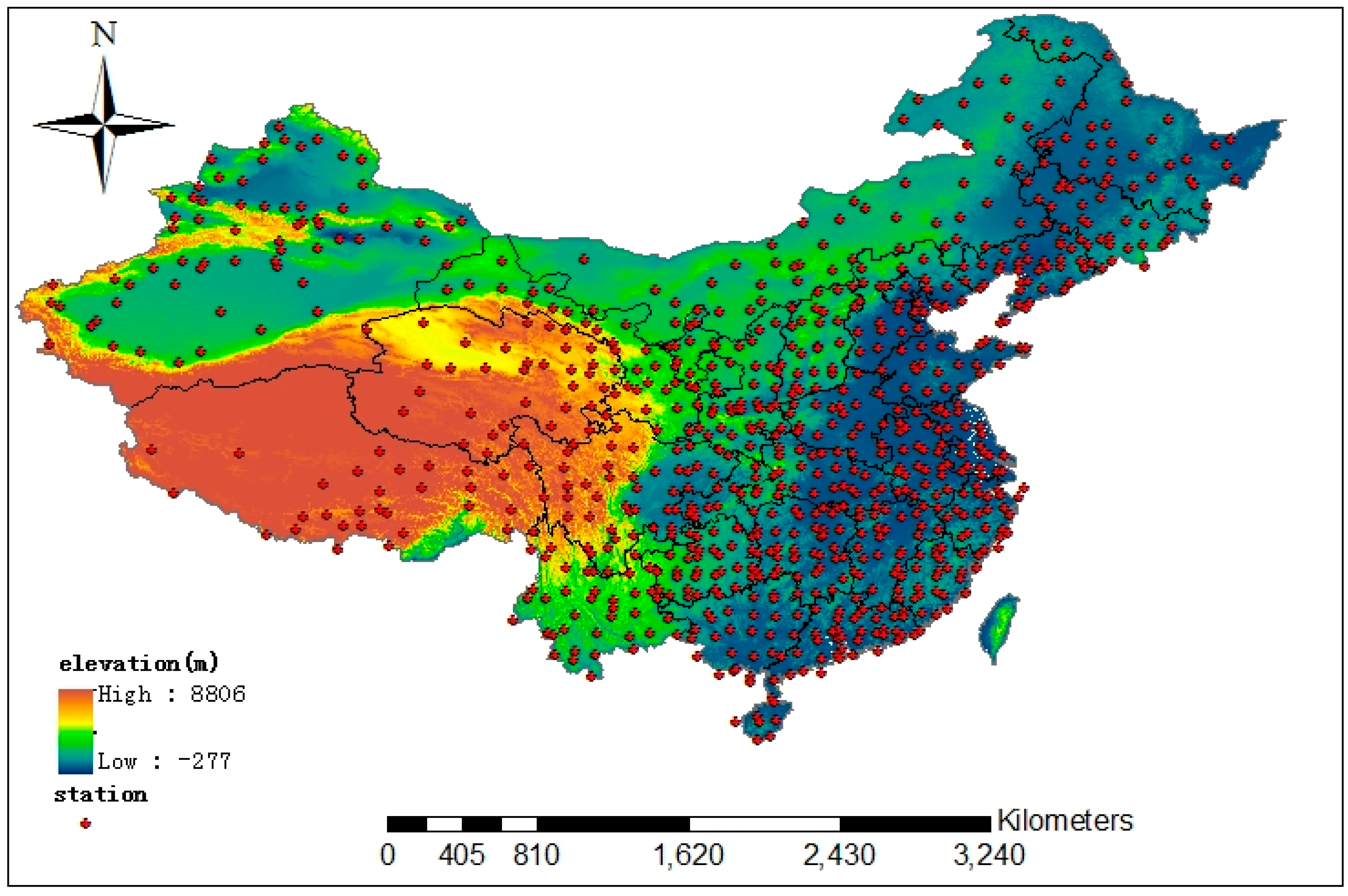
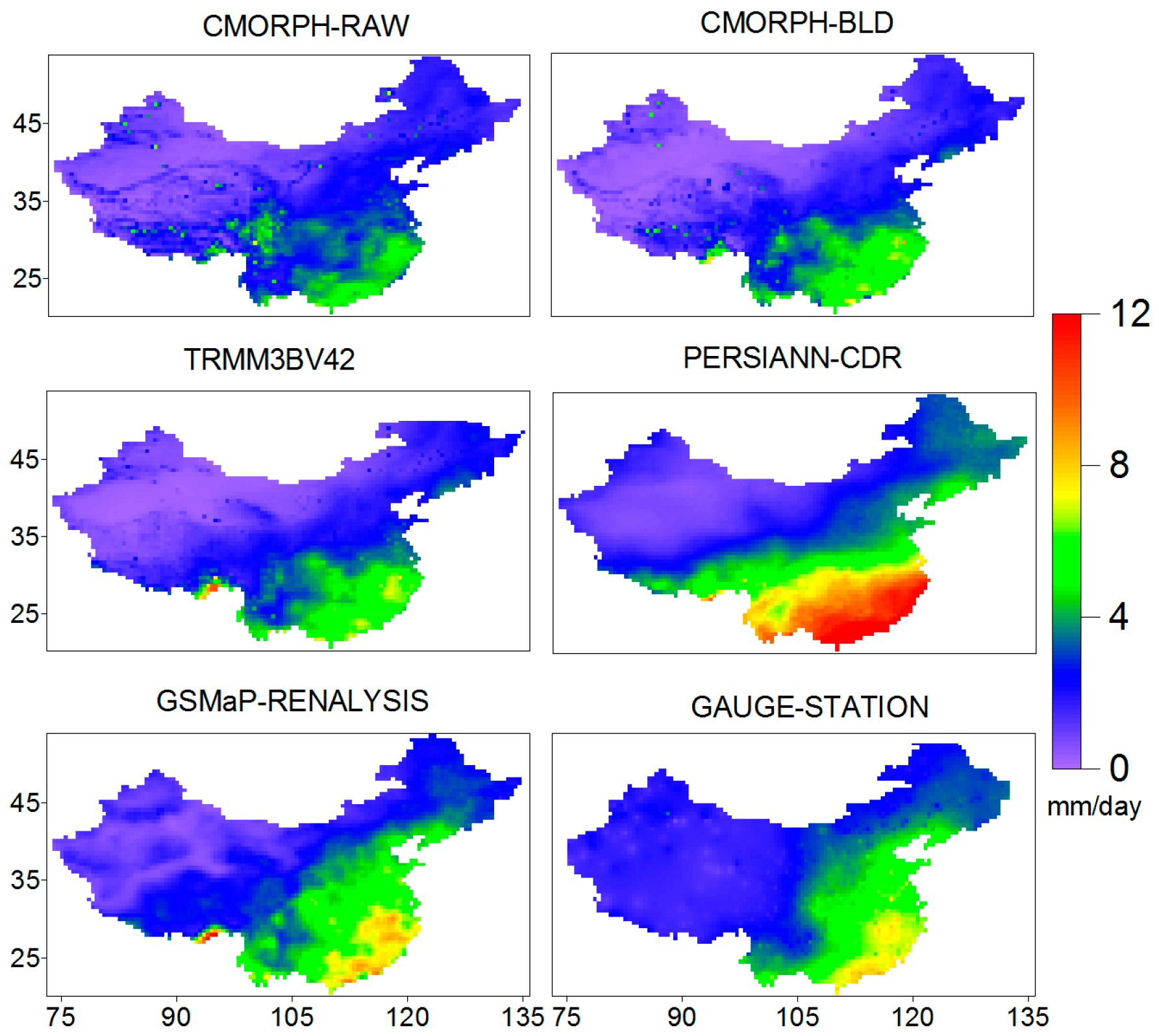
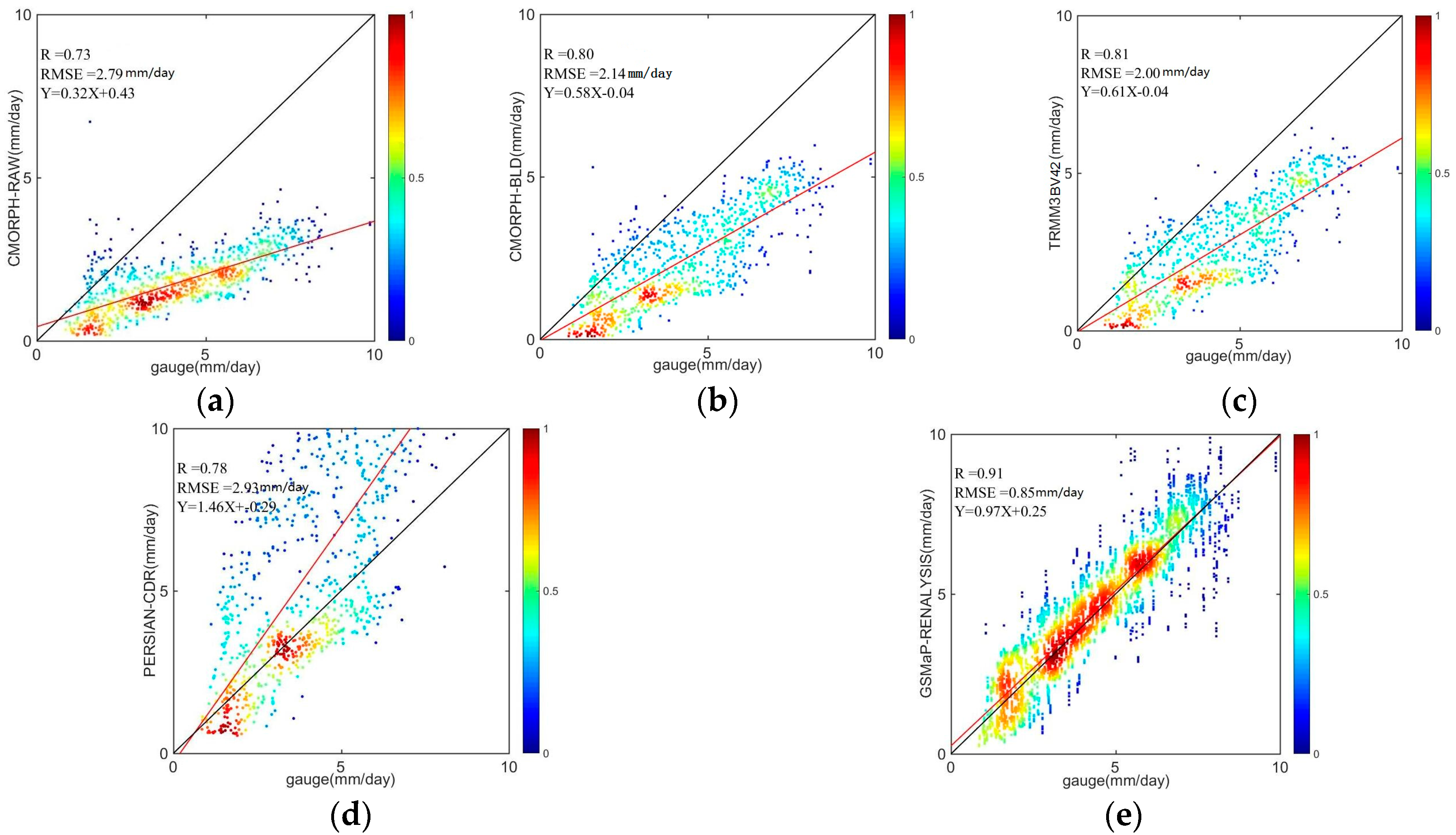
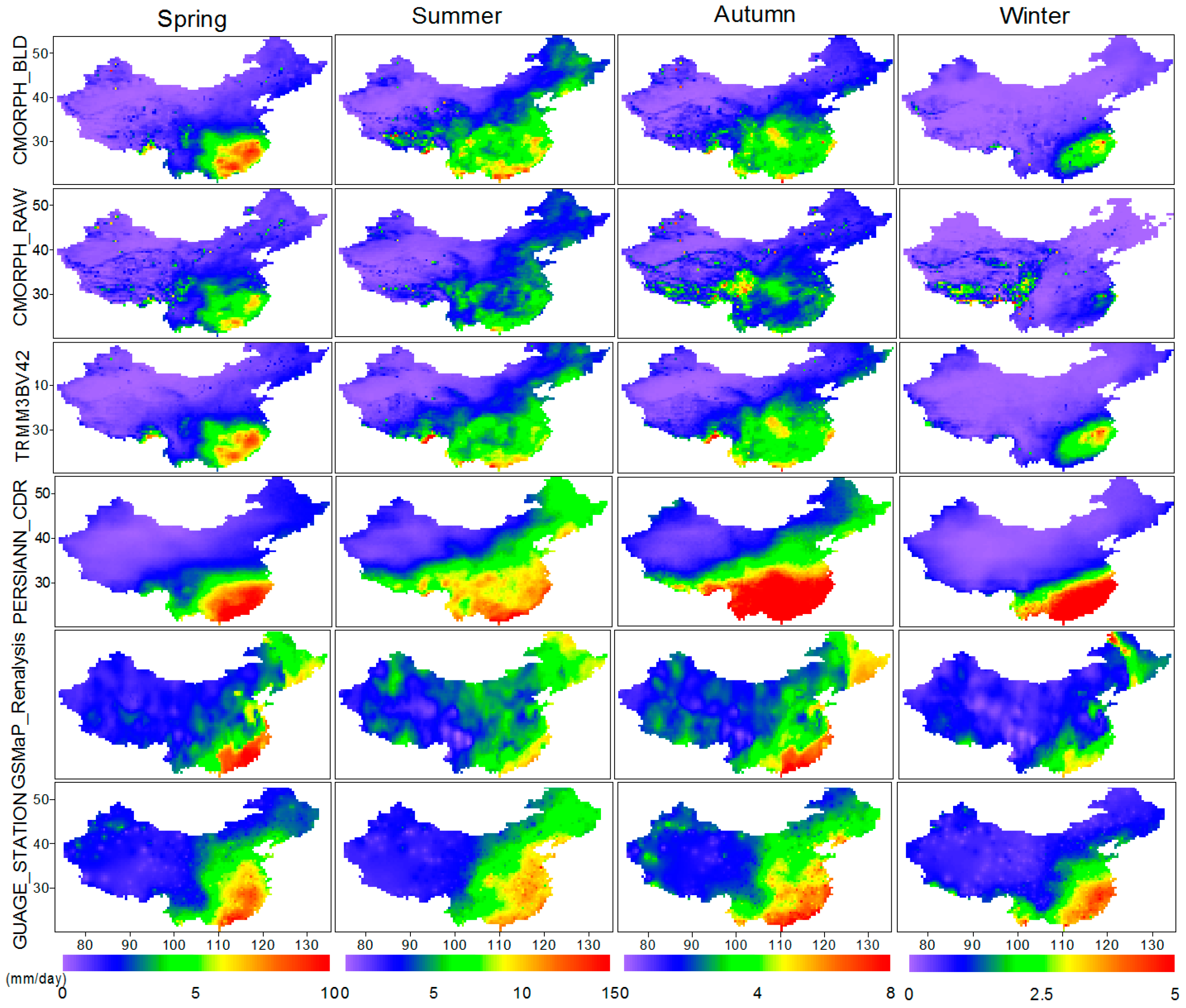

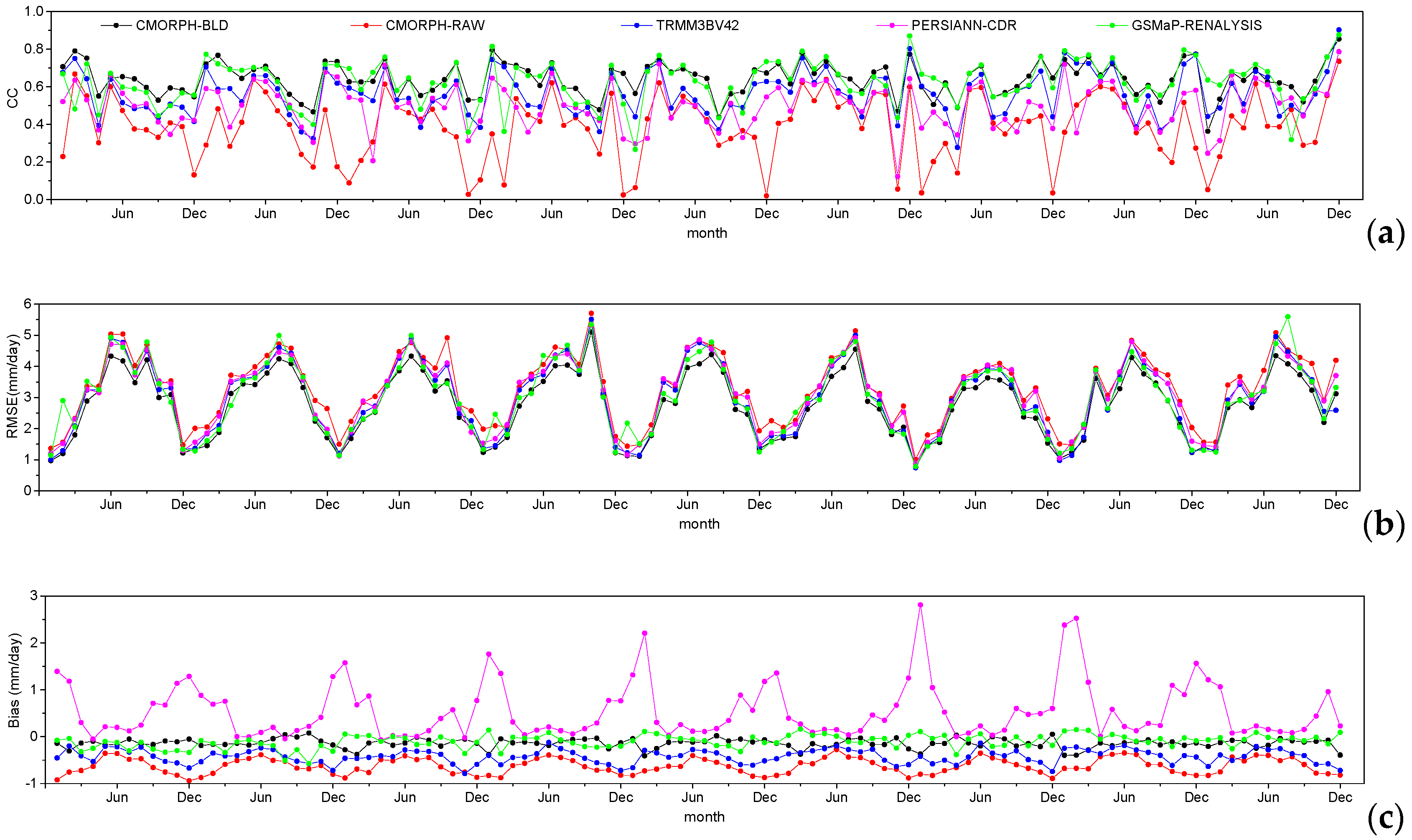
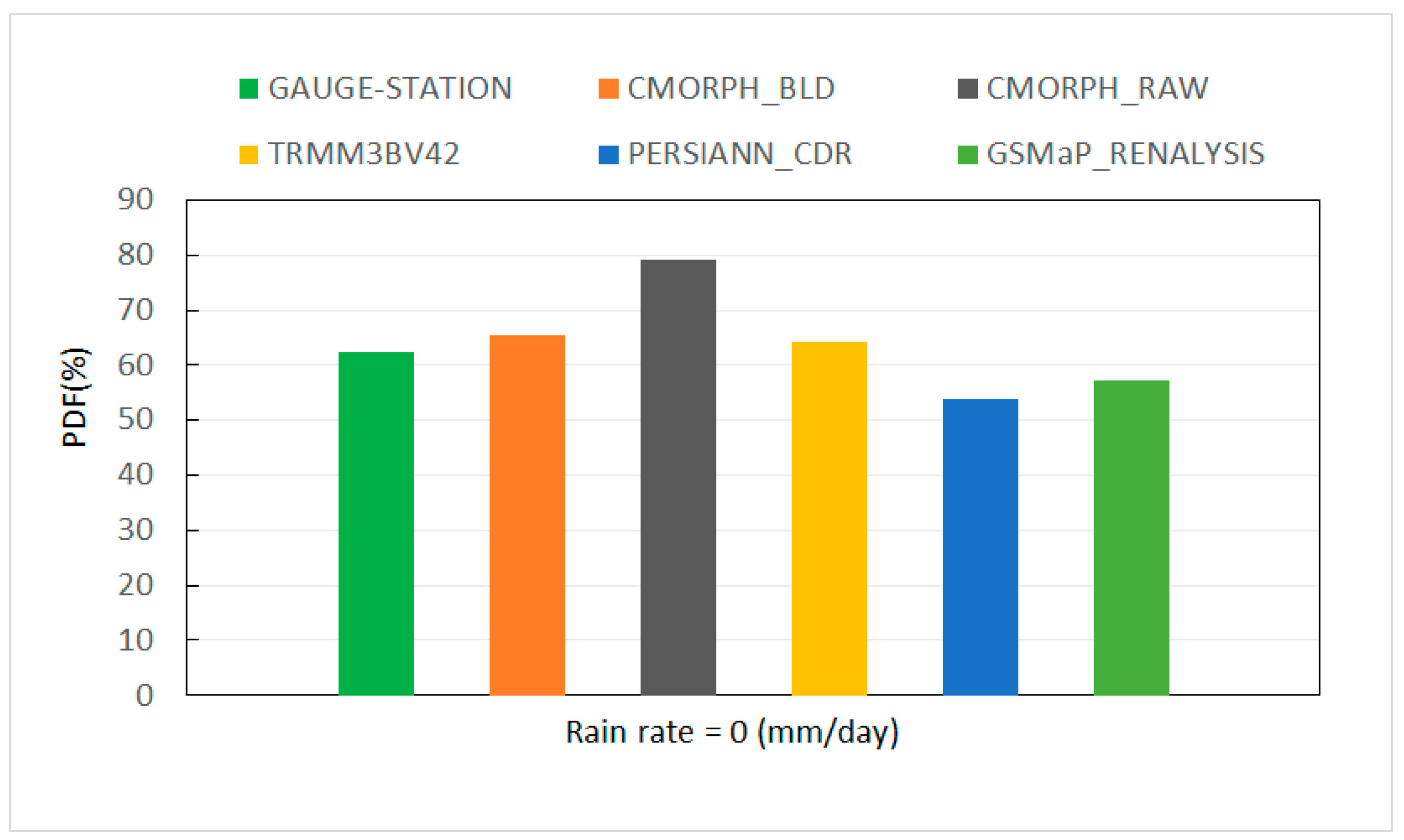
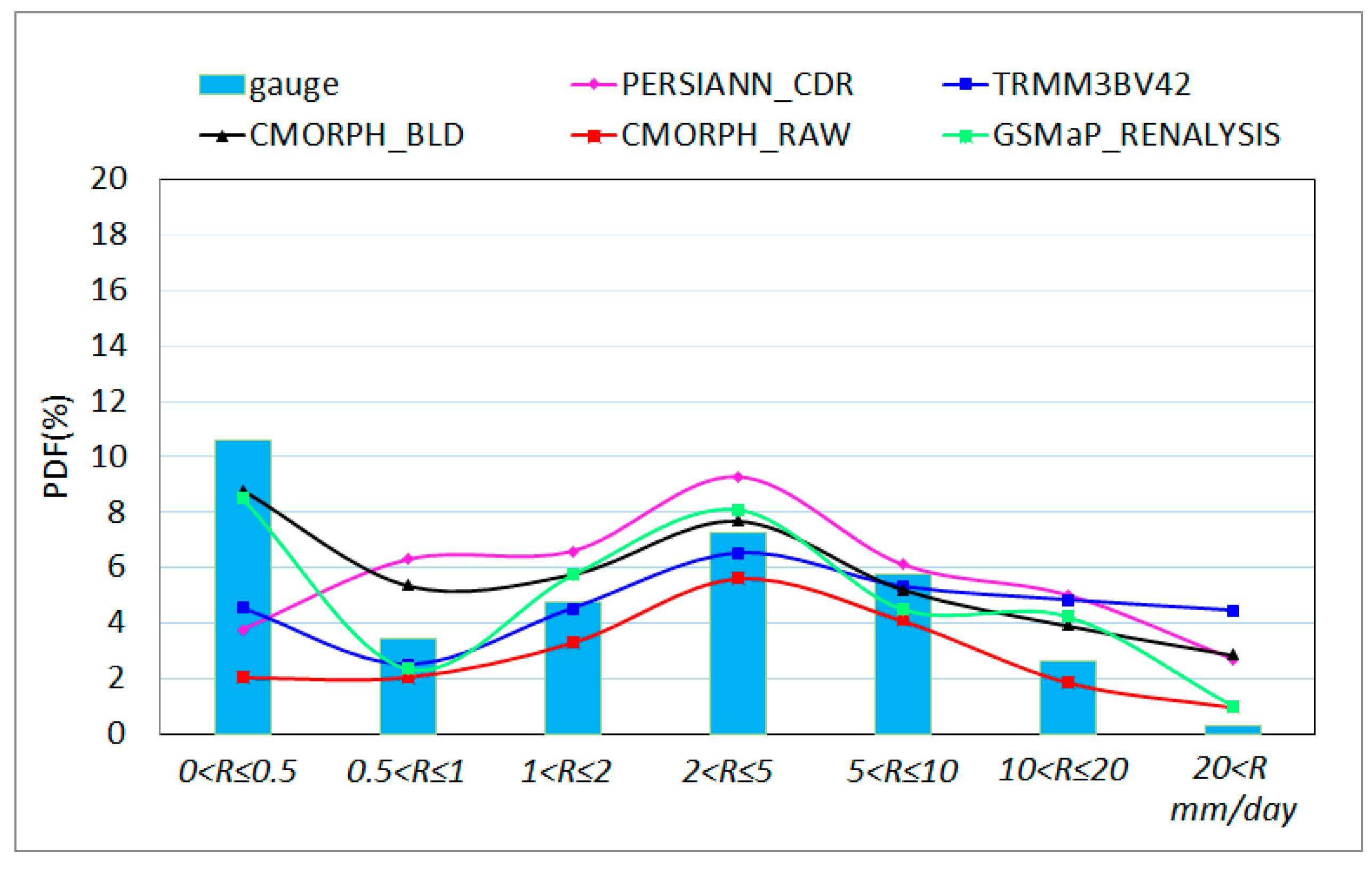
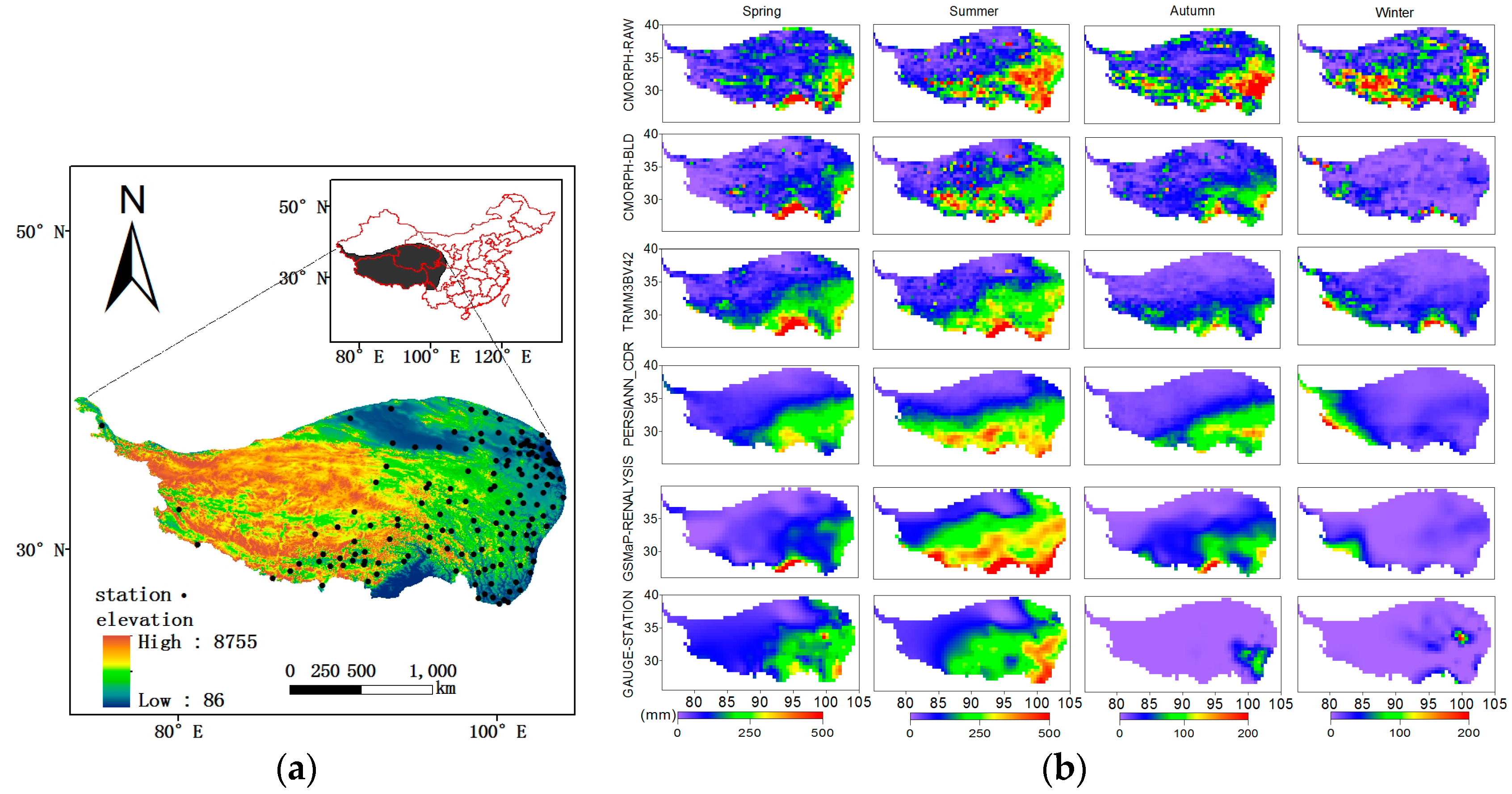



| Product | Temporal Resolution | Spatial Resolution | Domain | Yes or No Added Gauges |
|---|---|---|---|---|
| CMORPH_RAW | 1 day | 0.25° | 60°S–60°N | No |
| CMORPH_BLD | 1 day | 0.25° | 60°S–60°N | Yes |
| PERSIANN_CDR | 1 day | 0.25° | 60°S–60°N | Yes |
| GSMaP-RENALYSIS | 1 day | 0.1° | 60°S–60°N | Yes |
| TRMM3BV42 | 1 day | 0.25° | 50°S–50°N | Yes |
| Gauge ≥ Threshold | Gauge < Threshold | |
|---|---|---|
| Satellites ≥ threshold | H | F |
| Satellites < threshold | M | Z |
| Products | Factors | 2005 | 2006 | 2007 | 2008 | 2009 | 2010 | 2011 | 2012 | 2013 |
|---|---|---|---|---|---|---|---|---|---|---|
| CMORPH_BLD | CC | 0.74 | 0.82 | 0.70 | 0.75 | 0.76 | 0.77 | 0.74 | 0.76 | 0.76 |
| RMSE | 1.45 | 1.34 | 1.46 | 1.50 | 1.41 | 1.36 | 1.30 | 1.38 | 1.50 | |
| BIAS | −0.42 | −0.46 | −0.47 | −0.45 | −0.46 | −0.39 | −0.47 | −0.39 | −0.46 | |
| CMORPH_RAW | CC | 0.68 | 0.71 | 0.60 | 0.67 | 0.63 | 0.71 | 0.61 | 0.37 | 0.66 |
| RMSE | 1.57 | 1.63 | 1.65 | 1.69 | 1.70 | 1.53 | 1.56 | 1.61 | 1.77 | |
| BIAS | −0.58 | −0.57 | −0.56 | −0.58 | −0.62 | −0.54 | −0.59 | −0.55 | −0.57 | |
| TRMM3BV42 | CC | 0.74 | 0.83 | 0.70 | 0.76 | 0.76 | 0.78 | 0.76 | 0.78 | 0.79 |
| RMSE | 1.45 | 1.31 | 1.48 | 1.48 | 1.42 | 1.35 | 1.30 | 1.35 | 1.47 | |
| BIAS | −0.38 | −0.42 | −0.43 | −0.41 | −0.42 | −0.36 | −0.44 | −0.35 | −0.43 | |
| PERSIANN_CDR | CC | 0.73 | 0.80 | 0.67 | 0.72 | 0.67 | 0.73 | 0.71 | 0.73 | 0.80 |
| RMSE | 1.48 | 1.41 | 1.54 | 1.56 | 1.63 | 1.47 | 1.40 | 1.50 | 1.42 | |
| BIAS | 0.47 | 0.31 | 0.30 | 0.34 | 0.42 | 0.34 | 0.41 | 0.54 | 0.26 | |
| GSMaP_RENALYSIS | CC | 0.82 | 0.87 | 0.81 | 0.82 | 0.84 | 0.84 | 0.83 | 0.85 | 0.84 |
| RMSE | 1.28 | 1.21 | 1.28 | 1.42 | 1.23 | 1.36 | 1.16 | 1.19 | 1.27 | |
| BIAS | −0.05 | −0.11 | 0.04 | 0.03 | 0.04 | 0.07 | 0.02 | 0.05 | 0.01 |
| CMORPH_BLD | CMORPH_RAW | TRMM3B42 V | PERSIANN | GSMaP_RENALYSIS | |
|---|---|---|---|---|---|
| FBI | 1.27 | 1.13 | 1.00 | 1.03 | 1.01 |
| POD | 0.76 | 0.57 | 0.60 | 0.57 | 0.81 |
| CSI | 0.50 | 0.37 | 0.57 | 0.46 | 0.63 |
| FAR | 0.40 | 0.49 | 0.45 | 0.42 | 0.36 |
© 2018 by the authors. Licensee MDPI, Basel, Switzerland. This article is an open access article distributed under the terms and conditions of the Creative Commons Attribution (CC BY) license (http://creativecommons.org/licenses/by/4.0/).
Share and Cite
Zeng, Q.; Wang, Y.; Chen, L.; Wang, Z.; Zhu, H.; Li, B. Inter-Comparison and Evaluation of Remote Sensing Precipitation Products over China from 2005 to 2013. Remote Sens. 2018, 10, 168. https://doi.org/10.3390/rs10020168
Zeng Q, Wang Y, Chen L, Wang Z, Zhu H, Li B. Inter-Comparison and Evaluation of Remote Sensing Precipitation Products over China from 2005 to 2013. Remote Sensing. 2018; 10(2):168. https://doi.org/10.3390/rs10020168
Chicago/Turabian StyleZeng, Qiaolin, Yongqian Wang, Liangfu Chen, Zifeng Wang, Hao Zhu, and Bin Li. 2018. "Inter-Comparison and Evaluation of Remote Sensing Precipitation Products over China from 2005 to 2013" Remote Sensing 10, no. 2: 168. https://doi.org/10.3390/rs10020168




